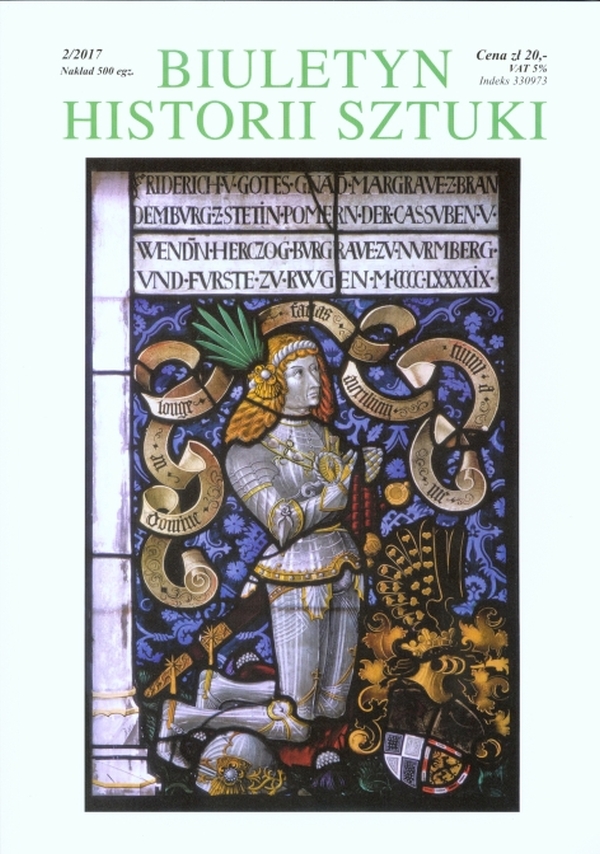Kolekcjoner obrazów w Warszawie na przełomie XIX i XX wieku.
Collector of Paintings in Warsaw at the Turn of the 19th and 20th Century.
On the Painting Collection of Count Juliusz Ostrowski.
Author(s): Kamila KłudkiewiczContributor(s): Author Not Specified (Editor)
Subject(s): Fine Arts / Performing Arts, Cultural history, Visual Arts, 19th Century, Sociology of Art
Published by: Instytut Sztuki Polskiej Akademii Nauk
Keywords: Count Juliusz Ostrowski (1854-1917); Jan Krywult; painting collection; art market; Society of Fine Arts "Zachęta"
Summary/Abstract: Analysis of the collection of Polish contemporary painting of Count Juliusz Ostrowski (1854-1917), previously little known in literature, is analyzed. Committed to social, Catholic, and scholar activity, the Count of Ujazd began to collect art works in the 1890s. Upon his death, the collection contained 250 works by Polish artists. On the grounds of the posthumous list of his movables, the analysis of Count Ostrowski’s collectorship decisions is conducted. Count Juliusz Ostrowski purchased art works only in Warsaw: at the ‘Zachęta’ exhibitions, from Warsaw art dealers (Józef Pawłowski Artistic Salon; Krywult Salon; Stanisław Malicki; Stefan Kulikowski Fine Arts Salon), and occasionally through their mediation from private individuals (e.g. Maria Chełmońska). The place particularly important for the history of the purchases of the Count of Ujazd was the ‘Zachęta’; being its regular member, at exhibitions he would occasionally buy paintings almost wholesale. Ostrowski owned pieces of Polish painting from the late 18th century to the early 19th century. The dominating feature was that the collection comprised works of the artists who were the collector’s contemporaries: Leon Wyczółkowski, Anna Bilińska-Bohdanowicz, Julian Fałat, Wacław Pawliszak, Henryk Siemiradzki, Juliusz Kossak, Jan Styka, Teodor Ziomek, Jacek Malczewski, Wlastimil Hofman, or Alfred Wierusz-Kowalski. Moreover, what stood out were a substantial number of pieces by Piotr Michałowski, this resulting from family connections and the fact that Juliusz Ostrowski had inherited them from his aunt and Michałowski’s wife, Julia Michałowska née Ostrowski. The comparison of the collection content in 1894 (the period of the most intense purchasing activity of the Count when he actually built a large collection from scratch) against that following his death in 1917, displays a shift in his preferences. When he first started buying paintings, he would mainly focus on mediocre artists who displayed their works in large numbers at the Zachęta. Such names as Antoni Austen, Alfonsa Kanigowska, Aleksander Kozłowski, Julian Maszyński, Stefan Popowski, Mieczysław Reyzner, Jan Rozen, Leon Szpądrowski, Feliks Cichocki, with time disappeared from the collection. In the early 20th century, Count Ostrowski started searching for works of the Gierymski brothers, Wyczółkowski, Pankiewicz, and Podkowiński. He may have come across Young Poland’s art in Warsaw: in private salons and galleries, but also at the Zachęta, undergoing a reform at the time. As a result, the collection of Count Juliusz Ostrowski turned to be an interesting assortment of Polish works in which next to mediocre amateurs’ pieces, also those by artists of major impact on Polish art at the turn of the 19th and 20th centuries could be found.
Journal: Biuletyn Historii Sztuki
- Issue Year: 79/2017
- Issue No: 2
- Page Range: 313-344
- Page Count: 32
- Language: Polish
- Content File-PDF

